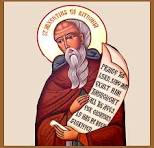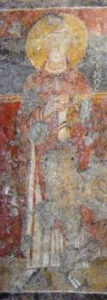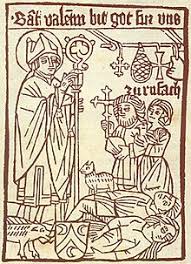
… at least not today in the Orthodox Church, when we commemorate Saints Auxentios, Maron and the martyrs Nicholas and Damian. No hearts and flowers there. We Orthodox do commemorate two Saint Valentines – one on July 6, the other on July 30
A Confusing Introduction
I thought this was going to be a simple Post to research and write. Wrong, as usual. The material on this subject is perplexing and hard to get at. I promise I’ll get some of it wrong. If there are any Valentine specialists here present, please correct me.
Because, all told, according to Orthodox Wiki, there were ten Saint Valentines. Some sources list as many as fourteen, though I think some are confused with others. In ancient times, both East and West, Valentine (Valentinus) was a popular men’s name (like John or James today), so it’s not surprising that some were saints, some of them martyrs. Almost certainly we know of only a few of them
In Western Christianity, at least two Valentines are commemorated on February 14. They appear to be the ones we Orthodox remember on the days mentioned above.
So today, for your edification and mine:
1 I’ll quickly run you through the various Saint Valentines. Some of the information about them appears to be what we might call very legendary. About some we know almost nothing.
2 Then we’ll come to the issue of how Saint Valentine’s Day came to be associated with hearts and flowers. * I thought there was a simple answer to that. There isn’t.
- and chocolates. Don’t forget the chocolates.
Therefore, on this February 14, first you are about to receive…
1 Many Valentines

Saint Valentine of Rome, celebrated on July 6 (though some say he’s the one on July 30) in the Orthodox Church, but on February 14 in the West. A presbyter who blessed married couples whom the Emperor Claudius II had forbidden to marry. He gave his life to protect the institution of Christian marriage. Beginning in the High Middle Ages, his feast day became associated with courtly love. Died February 14, 273.
I’ll tell you quite a lot about this Saint Valentine, because he has a definite Orthodox connection. The following paragraphs are from orthochristian.com
“After the martyrdom some Christians salvaged the body of the Saint and put a bit of his blood in a vile. The body of the martyr was moved and buried in the Catacombs of St. Priscilla, a burial place of most of the martyrs. Over the years somehow he was “forgotten” since almost every day there were buried in these catacombs new martyrs for several decades. The memory of Valentine’s martyrdom however remained robust, particularly in the local Church of Rome. Officially the memory of St. Valentine was established in 496 by Pope St. Gelasius.
“Fifteen centuries pass and we arrive at 1815, at which time the divine intention was to “disturb” the eternal repose of the Saint. Then the relics were donated by the Pope to a gentle Italian priest (according to the custom of the time). After this the relics are “lost” again until 1907 where we find them in Mytilene [Greek island[ in the Roman Catholic Church of Our Lady. It seems that after the death of the priest that a descendant of his had inherited the relics who had migrated to Mytilene, which was then a thriving community of West-European Catholic Christians. There they remained until 1990 when they were moved to Athens in the Church of Saints Francis and Clara’s Italian community, where they are today.”
Why we commemorate him on July 6 I have not discovered.
Saint Valentine, Bishop of Interamna (south central Italy) also known as Saint Valentine of Terni – commemorated on July 30 (some say he’s the one on July 6) in the Orthodox Church, but on February 14 in the West. He was known for his healing and wonderworking, especially of epilepsy. While temporarily in Rome he was imprisoned, tortured, and martyred there on February 14, 269.

Saint Valentine of Passau, Bishop, abbot, monk and hermit, who was a missionary from the Pope to Rhaetia (present day Switzerland and southern Germany). He died January 7, 475.
Saint Valentine of Genoa who in the Fourth Century aided monastic expansion. Died in the year 307. His relics were not discovered till 985 on May 2.
Saint Valentine of Trier in Germany. A bishop who was martyred during the persecutions of Diocletian at the beginning of the Third Century. Commemorated on July 16.
Saint Valentine of Strasbourg (Alsace, France), commemorated on September 2, believed to be the date of his martyrdom.
Saint Valentine of Viterbo * (central Italy), priest and missionary, beheaded on November 3 during a persecution of Emperor Diocletian.
- Just for your information, the Google map of Viterbo shows some holy sites and also “McDonald’s Viterbo Sao Paolo”.
Saint Valentine of Ravenna was a martyr with others in 305. Feast day December 16. Some sources list two other Saint Valentines of Ravenna, though it’s possible one or more of them were confused with Saint Vitale of Ravenna.
Saint Valentine of Africa *, martyred there, of whom nothing else is known, and for that reason was celebrated on February 14, with the other more famous Valentines.
- North Africa
There is also sometimes listed a Saint Valentine the Greek about whom nothing seems to be known. I wonder if he is the same as the first Saint Valentine listed above.
 2 Valentine Hearts and Flowers *
2 Valentine Hearts and Flowers *
- and candy. Don’t forget the chocolates.
I thought this had a simple explanation. It doesn’t.
In many places we read that the modern association of Saint Valentine with love and lovers developed out of the ancient Roman fertility feast of Lupercalia, which was celebrated on February 15. It is said that in early times the Church tacked that pagan celebration onto our celebration of Saint Valentine(s) on February 14. Thus Lupercalia was Christianized, or Saint Valentine was paganized, depending on one’s point of view.
That’s what I intended to write about today. It explains everything. Except for the fact that it didn’t happen.
Here is a description of Lupercalia.

“Each Lupercalia began with the sacrifice by the Luperci of goats and a dog, after which two of the Luperci were led to the altar, their foreheads were touched with a bloody knife, and the blood was wiped off with wool dipped in milk; the ritual required that the two young men laugh. The sacrificial feast followed, after which the Luperci cut thongs from the skins of the sacrificial animals and ran in two bands around the Palatine hill, striking with the thongs at any woman who came near them. A blow from the thong was supposed to render a woman fertile.” from Encyclopedia Brittanica Some other accounts describe the celebration as considerably more erotic.
In the first place, it would certainly be difficult for the Church to turn any part of that ceremony into a celebration of romantic love! Besides, romantic love as we know it did not exist in those days. Marriages then were arranged by the families and had no basis in what we now call romance, which is a relatively modern thing. Many pagan young men in various ways “sowed their oats”, as we used to describe it, but that had nothing to do with love.
Add to that the fact that there is no evidence whatever that the ancient Church celebrated love on Saint Valentine’s Day. Apparently that first came with Chaucer in the Thirteenth Century.
Here is a well-written and more extensive account of the above. https://www.johnsanidopoulos.com/2020/02/the-myth-of-pagan-origins-of-valentines.html
- If you want to keep up with the Church’s calendar of saints, day by day, there is no better place than Mr Sadinopoulos’ Blog, which contains a vast amount of material, easily accessible: https://www.mystagogyresourcecenter.com
All the cute little Cupids on the Valentine cards look positively pagan, but they’re not. Cupid was the Roman god of love – actually the Greek god Eros.When he shot you with his arrow, you were charged with uncontrollable passion, not love.
During the Nineteenth Century, in England, the custom began of sending cards to loved ones on Valentine’s Day. At the time pagan deities were fashionable, though not worshiped. (“By Jove” [Jupiter), the elegant English gentleman might say, because “By God” wasn’t nice.) So it was natural to want Cupid, the god of “love”, on the cards. However, Victorian folk definitely did not want to put (forgive me) this, the real Cupid, on a Valentine card…

…so he was reduced to this.

So, despite all, modern Valentine’s Day is neither particularly Christian nor particularly pagan. You notice that almost nobody calls it Saint Valentine’s Day any more. During February the Hallmark Channel goes into overdrive * with their even-sweeter-than-usual romantic stories, but with no naked pagan gods and (so far as I know, and I hope I’m wrong) nary a mention of God.
- an ancient expressiono. Look it up.

And that is the story of our modern Valentine extravaganza. I should add that I love it, and I hope you do too. Enjoy the hearts and flowers.*
- and candy. Don’t forget the chocolates.
One more thing.
The Orthodox Church needs to develop a pastoral theology of romantic love and what to do with it. (A “theology” because God must be at the center of all things.) Through almost all of Orthodox history (and still in some places) marriages were arranged by families, and romance had nothing to do with it. Almost all of Orthodox theology was written by monks – God bless them, but they really wouldn’t understand, would they? Saint John Chrysostom had many good things to say about marriage and family, but addressed almost entirely to the men.
Romantic love, as we know it is a fairly new thing, and it involves both men and women: couples seeking each other on their own, “falling in love”, loving each other not only because of eros, but also because of the quality of the other person, how much they enjoy each other and find lovable in their character, their personality. .
We need Orthodox guidance for our people about how to “handle” romantic love (eros), how to enlarge it into agape, which is what keeps marriage alive over the years. I’ve been married nearly 58 years now. When I tell my wife “I love you”, it still has something of the old thrill, but it also has a much “fuller” feeling and meaning, now – I don’t know how else to express it.
Another thing that might be discussed: What about the on-line “dating” sites by which young Orthodox men and women are meeting each other these days, not in person but by Zoom, for example. Is this a good thing or not? I know a number of very good marriages that have resulted from this. But it’s also missing something: They can’t hold hands that way. I feel certain they don’t kiss the screen! It’s easy to be misled when the person isn’t present with you.
And there’s more.
Perhaps this has all been studied and written about. I hope so.
Next Week: Preparing your family for a good Lent
Week after Next: The Church’s Last Minute Instructions before Lent
Sources consulted in the Post above:
Catholic Encyclopedia
Encyclopedia Brittanica,
Orthodox Wiki
orthochristian.com,
orthodoxcchristian.com
https://blogs.goarch.org/blog/-/blogs/is-valentine-s-day-an-orthodox-feast-day-
Normally this post is informative and constructive andeducational. On St. Valentine the author seems to be stuck in some preconceived ideas disregardings the possibility of evolution in concepts and ideas of love and marriage, and what the Church has taught over the centuries. He seems stuck somewhere before th tenth century, okay the fifteenth as he disregards writings and authorship on the topic. As we have added to the calendar saints and events, so too with Love and Marriage. His sources are good but Mr. Sanidopoulos simple translates from the Greek Synaxarion repeating the old cliches, sometimes erroneous information, but still informative in the main on the live of the saint. Since Mr. Sanidopoulos selectively chooses his sources (I have checked up on many of them and others) he does occasionallly fall short with his accuracy. We thank the current author and Mr. Sanidopoulos for leading the way. But please try for accurcy and updated sources!
Hey, I promised to make some mistakes.
Please, what are some of the “updated sources” you refer to? I want to be accurate and perhaps add a P.S. to the Post.
Father Bill